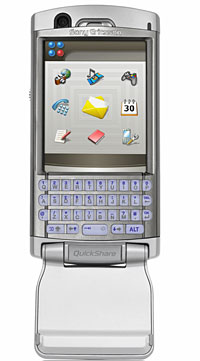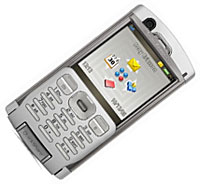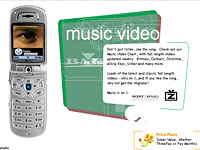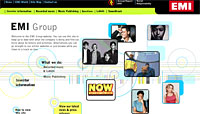 Handy… Literally!
Handy… Literally!
Engadget has a story on how Montclair State University in New Jersey is handing out free phones to it’s students to enable them to easier communicate with each other. The handsets feature software which allows them to receive “channels” of information, which users sign up for. These channels include things like the dinner menu and the location of the university’s shuttle buses, as well as channels students have set up of their own.
I can admit I am actually kind of jealous of this: I would love the ability to be able to do this at school, checking up on when holidays are, what’s on the menu, and what my time-table’s like. Sadly, I think my school would have some difficulty in preventing the chavs from selling them on eBay, which of course is an entirely different issue.
This is the problem with technology like this: Those most likely to adopt it are, by default, young people, who therefore can’t afford it. Give it to them instead then, and a select few will take advantage of that. Technology like this, for now, is only for older people I think. This isn’t to say it isn’t exciting though: I still find socio-technological implementations, usually referred to as MoSoSo (Mobile Social Software), fascinating, as although there isn’t yet much of a market for these sorts of services, there will inevitably be, and when there is, it could well change the way we communicate with each other forever.
 Sounds nasty!
Sounds nasty!
Everyone over here in Europe likes to text, or “txt” for short. I’m not entirely sure how popular the practice is over in the US, but in the UK it’s used mainly by teenagers, although others use it too, because of it’s extremely low cost in comparison to making voice calls.
The New York Times is reporting that apparently, using SPAMming techniques, it should be possible to flood a cities GSM infrastructure by sending as little as 165 text messages a second into the network. This is made possible because text messages use the same communications infrastructure and network that voice calls are made to as well. Imagine what could happen if someone flooded a network, so that no calls could be made, and then at the same time a co-ordinated terrorist attack occurred. People would be unable to call the emergency services, and wide-spread carnage and destruction would occur.
This is particularly scary for me, as I would be at a loss in an emergency without my phone: It’s central to how I find people and communicate with them, and when I really need to get in touch with them, I wouldn’t be able to. This reliance and taking for granted of technology is something that most of my generation are likely guilty of, and when everything does kick off and there’s no electricity, phones or water, I would have severe doubts that a lot of them would be able to cope with it.
It was only really recent events (London bombings) that brought this to my attention, but it has made me realise that reliance on technology could be very turned around and be used against us.
 That lot again
That lot again
Yes, that’s right, the RIAA are at it again: A short time ago, a case against a mother on her daughter’s behalf of file sharing was dismissed in court. Now, the RIAA are back, but this time, they’re not suing the mother but her 14-year old daughter.
People like the RIAA make me so, so angry: At 14, no-one really knows what they’re doing. So a little girl downloaded some of her favourite songs from the Internet. That little girl was probably a paying customer as well, but her pocket money just wasn’t enough, and she just wanted to hear one more song by her favourite artist, but couldn’t afford it. Her friend said “you can get it for free from here”, and so that’s what the girl did. Next thing she knew, the very company she was a customer of, was sending threatening letters to her, demanding thousands of dollars in compensation.
Is this the right way of treating your customers? I know for sure it is one great way of driving them away. If you are in my position at the moment, of having a good few thousand songs you enjoy, then stop buying music unless it is from your local bands or from an independent label. It might sound an unrealistic expectation, but I have found so many great bands on the Internet and locally at pubs and other music venues, that I am quite confident I will never be giving another penny to those greedy folks over at the RIAA.
You can do something about it though, by going to www.boycott-riaa.com. Every little helps!
That would be my rant for the day, have a nice weekend :-)
 Sony Ericsson has beefed up its flagship P-series smartphone range with the new 3G P990 phone.
Sony Ericsson has beefed up its flagship P-series smartphone range with the new 3G P990 phone. Naturally, Sony are keen to shove their oar into Blackberry’s waters, with the P990 prepared for all major push e-mail clients enabling full e-mail access with attachments.
Naturally, Sony are keen to shove their oar into Blackberry’s waters, with the P990 prepared for all major push e-mail clients enabling full e-mail access with attachments. The P990 will be the first commercially available smartphone to use the enhanced Symbian OS version 9.1 and the UIQ 3.0 user interface, which has been optimised for one handed use.
The P990 will be the first commercially available smartphone to use the enhanced Symbian OS version 9.1 and the UIQ 3.0 user interface, which has been optimised for one handed use. Fujifilm has announced the Fujifilm FinePix Z2 Zoom, a new member of the superslim Z-series, offering 5.1 megapixel resolution and sensitivity up to ISO 1600.
Fujifilm has announced the Fujifilm FinePix Z2 Zoom, a new member of the superslim Z-series, offering 5.1 megapixel resolution and sensitivity up to ISO 1600.  The FinePix Z2 Zoom comes with the same reinforced glass 2.5″ screen, but now boasts a higher resolution of 232,000 pixels, and the camera offers a wider aperture range up to F8.0, improved metering (256-zone, up from 64-zone) and a longer maximum shutter speed of four seconds.
The FinePix Z2 Zoom comes with the same reinforced glass 2.5″ screen, but now boasts a higher resolution of 232,000 pixels, and the camera offers a wider aperture range up to F8.0, improved metering (256-zone, up from 64-zone) and a longer maximum shutter speed of four seconds. In the real world, the camera’s 3x optical zoom (36 – 108 mm, 35 mm equiv) means that anyone looking to snap a Kate Moss exclusive will have to be pretty close to the catwalk, with the camera’s slow f3.5 – 4.2 lens meaning that higher (and noisier) ISOs would be needed to capture any drug-fuelled stumblings.
In the real world, the camera’s 3x optical zoom (36 – 108 mm, 35 mm equiv) means that anyone looking to snap a Kate Moss exclusive will have to be pretty close to the catwalk, with the camera’s slow f3.5 – 4.2 lens meaning that higher (and noisier) ISOs would be needed to capture any drug-fuelled stumblings. Adrian Clarke, Fujifilm’s Director of Photo Products, was on hand to talk about irony: “It’s ironic that most ultra-slim cameras struggle where they are most frequently used – in low-light social situations, such as parties. With four times the sensitivity, combined with iconic design, the FinePix Z2 Zoom is a camera that truly qualifies as an evening companion.”
Adrian Clarke, Fujifilm’s Director of Photo Products, was on hand to talk about irony: “It’s ironic that most ultra-slim cameras struggle where they are most frequently used – in low-light social situations, such as parties. With four times the sensitivity, combined with iconic design, the FinePix Z2 Zoom is a camera that truly qualifies as an evening companion.” Keen to get their size nines stamped all over the fast-growing podcasting revolution, Yahoo have launched a spanking new podcast service designed to make it easy for punters to rummage through the zillions of audio files available and find the stuff that interest them.
Keen to get their size nines stamped all over the fast-growing podcasting revolution, Yahoo have launched a spanking new podcast service designed to make it easy for punters to rummage through the zillions of audio files available and find the stuff that interest them. Surfers will also be able to listen to or subscribe to RSS (Really Simple Syndication) feeds for individual shows, episodes or entire series.
Surfers will also be able to listen to or subscribe to RSS (Really Simple Syndication) feeds for individual shows, episodes or entire series. The service will offer a unique feature that lets users find content quicker by speeding up playback without the the broadcaster’s voice sounding like Mickey Mouse on helium.
The service will offer a unique feature that lets users find content quicker by speeding up playback without the the broadcaster’s voice sounding like Mickey Mouse on helium. Unlike rival Podcast search sites, Yahoo! isn’t bundling in tools for creating podcasts at the moment, although that’s likely to happen in the future, with Joe Hayashi, Yahoo!’s director of product management saying, “This is all about discovery for now. Step One is all about growing the ecosystem.
Unlike rival Podcast search sites, Yahoo! isn’t bundling in tools for creating podcasts at the moment, although that’s likely to happen in the future, with Joe Hayashi, Yahoo!’s director of product management saying, “This is all about discovery for now. Step One is all about growing the ecosystem. Anybody who really thinks that T-Mobile is behind the new “Web’n’Walk” offering it trotted out last week, has really not being paying attention. It’s Google Talk, a VoIP service normally available for PC users, now sneakily able to go out over 3G data services.
Anybody who really thinks that T-Mobile is behind the new “Web’n’Walk” offering it trotted out last week, has really not being paying attention. It’s Google Talk, a VoIP service normally available for PC users, now sneakily able to go out over 3G data services. Officially, the new service gives you the Web in your pocket. This is not new; the Opera press release went out announcing Web’n’Walk back in June! it would only have been in any sense new last month, if we were discussing the “3” Internet service was being leaked, since Hutchison had previously been resolutely adamant that its users would have access only to the “3” web in a walled garden. That news was known to NewsWireless readers back in broke in early September: Hutchison will be opening up its 3G phones to full Internet browsing shortly.
Officially, the new service gives you the Web in your pocket. This is not new; the Opera press release went out announcing Web’n’Walk back in June! it would only have been in any sense new last month, if we were discussing the “3” Internet service was being leaked, since Hutchison had previously been resolutely adamant that its users would have access only to the “3” web in a walled garden. That news was known to NewsWireless readers back in broke in early September: Hutchison will be opening up its 3G phones to full Internet browsing shortly.  Can UMTS really compete?
Can UMTS really compete? Samsung Electronics have announced a new slim-line phone with an automatic “flying mode” function.
Samsung Electronics have announced a new slim-line phone with an automatic “flying mode” function. It’s quite an attractive looking phone, with the pocket-untroubling 15.9 mm case coming in a natty black and silver finish with a large-ish LCD and a small sliding keyboard.
It’s quite an attractive looking phone, with the pocket-untroubling 15.9 mm case coming in a natty black and silver finish with a large-ish LCD and a small sliding keyboard. A new study has revealed that one in five Americans is without home Internet access and have never been online, potentially hindering their access to crucial information and services.
A new study has revealed that one in five Americans is without home Internet access and have never been online, potentially hindering their access to crucial information and services.  Not surprisingly, the study also found that people with lower incomes and less education also registered lower percentages of Internet adoption.
Not surprisingly, the study also found that people with lower incomes and less education also registered lower percentages of Internet adoption. Broadband makes it easier for surfers to whiz around the Web and download music, view videos, enjoy free VoIP calls and access online services and important information on topics like health and finance.
Broadband makes it easier for surfers to whiz around the Web and download music, view videos, enjoy free VoIP calls and access online services and important information on topics like health and finance. 3G network operators 3 have announced a partnership with EMI Music UK to supply full-length music videos directly to the company’s 3 million customers.
3G network operators 3 have announced a partnership with EMI Music UK to supply full-length music videos directly to the company’s 3 million customers. The tie-up with EMI means that 3 subscribers can access a veritable cornucopia of audio/visual delights on their phones, with the new video material adding to the wireless operator’s bulging music catalogue, which includes full-length video and audio titles from Sony BMG and indie music videos supplied by VidZone.
The tie-up with EMI means that 3 subscribers can access a veritable cornucopia of audio/visual delights on their phones, with the new video material adding to the wireless operator’s bulging music catalogue, which includes full-length video and audio titles from Sony BMG and indie music videos supplied by VidZone. Next up on the back-slap promenade was Dave Gould, Commercial Manager, Digital Media for EMI Music UK: “We’re delighted to bring videos from EMI Music UK’s labels to 3. 3 is a leading network in bringing mobile music to its customers and we’re really excited about working with them to allow fans to catch up with their favourite artists anywhere and at anytime.”
Next up on the back-slap promenade was Dave Gould, Commercial Manager, Digital Media for EMI Music UK: “We’re delighted to bring videos from EMI Music UK’s labels to 3. 3 is a leading network in bringing mobile music to its customers and we’re really excited about working with them to allow fans to catch up with their favourite artists anywhere and at anytime.” Handy… Literally!
Handy… Literally! Sounds nasty!
Sounds nasty! That lot again
That lot again The 2006 world championships draw closer and if you‘ve not yet considered your Christmas gift list, this might be just the thing you were looking for.
The 2006 world championships draw closer and if you‘ve not yet considered your Christmas gift list, this might be just the thing you were looking for. Aussie God squadders looking to get down with Da Yoot have translated all 31,173 verses of the Bible into SMS text-speak.
Aussie God squadders looking to get down with Da Yoot have translated all 31,173 verses of the Bible into SMS text-speak. The translations were based on the Contemporary English Version and remained faithful to the grammar, with just the spellings being altered.
The translations were based on the Contemporary English Version and remained faithful to the grammar, with just the spellings being altered.